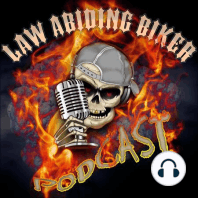71 min listen

LAB-134-Harley-Davidson Alternators, Stators, Regulators, Rectifiers-Charging System | Complete Guide
LAB-134-Harley-Davidson Alternators, Stators, Regulators, Rectifiers-Charging System | Complete Guide
ratings:
Length:
61 minutes
Released:
Feb 23, 2017
Format:
Podcast episode
Description
Official website: http://www.lawabidingbiker.com Podcast-A special thanks to guest Evan Grist of Fort Collins, Colorado, who is an electrical engineer and affiliated with RMSTATOR, a manufacturer of high-end power sports electrical parts. Via Skype, we were able to bounce our questions off Evan. In this episode, we'll teach you everything you need to know about your Harley-Davidson charging system. We break it down to what bikers actually need to know in an understandable way. Your Harley-Davidson, or most motorcycles for that matter, use the same type of charging system, often referred to as a permanent magnet alternator. In a car, an alternator is belt driven. In a motorcycle, it is driven by magnets embedded around the flywheel. The flywheel is permanently affixed to the crankshaft, which is spinning with the engine RPM's. Check out the Official Law Abiding Biker Store! So, the easy way to generate power is with a stator inside that flywheel magnet system. A stator is a metal core and is made up of a bunch of stamped steel plates that are riveted together. It's insulated with some sort of powder coat or plastic to protect the wires. There are windings wrapped around it, which are a particular gauge of solid core copper wire that's insulated. So, you end up with coils of wire wrapped around the stator. Those are attached to a wiring harness, which exits the side case of the motor & heads to the regulator/rectifier. And finally, to the battery to charge it. With the motor running, you have your crankshaft spinning with the flywheel attached to the end with the magnets spinning outside of the stator. Those magnets spinning past and around the metal core with wire wrapped around it generates electricity. And there you have it. You may hear this referred to as an alternator at times. If you hear someone call this an alternator on a motorcycle, they are generally referring to the entire package, the flywheel and stator. You do see Harley-Davidson refer to it as an alternator in their manuals. Regulator/Rectifier: The alternate current (AC) current created by the stator cannot be sent directly to the battery. It needs to be prepared, limited, and changed to direct current (DC) to correctly charge your battery. The current would destroy your battery if not first sent to the regulator/rectifier. In a motorcycle, the stator flywheel set up creates electricity and sends it to a separate regulator/rectifier. In a car, the rectifier/regulator is built into the alternator. On a Harley-Davidson, you'll recognize the separate regulator/rectifier as a little black box with cooling fins machined into it and it often times sits up front behind the rear tire attached to the frame. Regulator/Rectifier=2 Functions: Rectifier: The rectifier is responsible for converting the alternate current (AC) current created by the stator to direct current (DC). Basically, it chops off the negative polarity portion of the current that the battery can't use. Then it passes the current to the battery. Regulator: The regulator protects the battery voltage and when the battery voltage climbs too high it shuts off current to ground and bleeds it off as heat. That is what the heat fins on the regulator box are for, to dissipate the heat. If the regulator did not monitor the voltage to your battery it would destroy it. Note: Often times a bad regulator can do just that, send too much voltage to the battery. Battery: All the current required to run your motorcycle comes from your battery. The stator system charges your battery and replenishes it. You could actually run your motorcycle just fine for some time without a working stator as the battery has reserve current. Of course, the battery would eventually die. Aftermarket High Output Stators: If you add too many electrical accessories then you'll come a point that your stator just can't produce enough current to keep the battery charged. There may be subtle hints over time-like your bike starter is sluggish
Released:
Feb 23, 2017
Format:
Podcast episode
Titles in the series (100)
LAB-Sons of Anarchy (SOA) | Season 6; Episodes 5 & 6: CLICK HERE FOR THE OFFICIAL LAW ABIDING BIKER WEBISTE PODCAST-In this episode of the Law Abiding Biker Motorcycle Podcast we recap and discuss Son’s of Anarchy (SOA) Season 6; Episodes 5 & 6. The episodes aired on the FX Network on October 8... by Law Abiding Biker | Street Biker Motorcycle Podcast